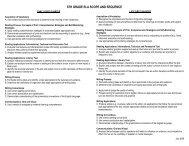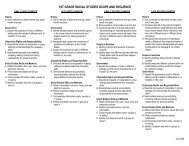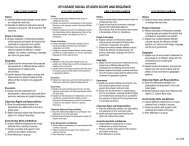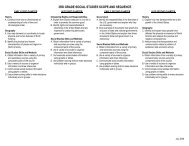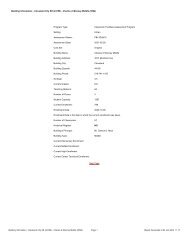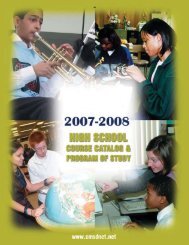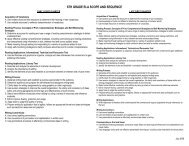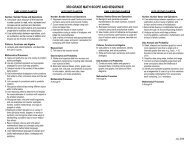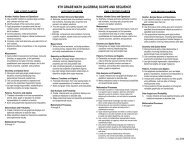6TH GRADE SCIENCE SCOPE AND SEQUENCE
6TH GRADE SCIENCE SCOPE AND SEQUENCE
6TH GRADE SCIENCE SCOPE AND SEQUENCE
You also want an ePaper? Increase the reach of your titles
YUMPU automatically turns print PDFs into web optimized ePapers that Google loves.
EARLY FIRST QUARTER<strong>6TH</strong> <strong>GRADE</strong> <strong>SCIENCE</strong> <strong>SCOPE</strong> <strong>AND</strong> <strong>SEQUENCE</strong>LATE FIRST QUARTEREARLY SECOND QUARTERLATE SECOND QUARTERLife SciencesC. Explain how energy entering theecosystems as sunlight supports the life oforganisms through photosynthesis and thetransfer of energy through the interactionsof organisms and the environment.Scientific InquiryA. Explain that there are differing sets ofprocedures for guiding scientificinvestigations and procedures aredetermined by the nature of theinvestigation, safety considerations andappropriate tools.B. Analyze and interpret data from scientificinvestigations using appropriatemathematical skills in order to draw validconclusions.Scientific Ways of KnowingA. Use skills of scientific inquiry processes(e.g., hypothesis, record keeping,description and explanation).B. Explain the importance of reproducibility andreduction of bias in scientific methods.C. Give examples of how thinking scientificallyis helpful in daily life.Physical Sciences.C. Describe renewable and nonrenewablesources of energy (e.g., solar, wind, fossilfuels, biomass, hydroelectricity, geothermaland nuclear energy) and the managementof these sources.Scientific InquiryA. Explain that there are differing sets ofprocedures for guiding scientificinvestigations and procedures aredetermined by the nature of theinvestigation, safety considerations andappropriate tools.B. Analyze and interpret data from scientificinvestigations using appropriatemathematical skills in order to draw validconclusions.Scientific Ways of KnowingA. Use skills of scientific inquiry processes(e.g., hypothesis, record keeping,description and explanation).B. Explain the importance of reproducibility andreduction of bias in scientific methods.C. Give examples of how thinking scientificallyis helpful in daily life.Earth and Space SciencesD. Identify that the lithosphere contains rocksand minerals and that minerals make uprocks. Describe how rocks and minerals areformed and/or classified.Scientific InquiryA. Explain that there are differing sets ofprocedures for guiding scientificinvestigations and procedures aredetermined by the nature of theinvestigation, safety considerations andappropriate tools.B. Analyze and interpret data from scientificinvestigations using appropriatemathematical skills in order to draw validconclusions.Scientific Ways of KnowingA. Use skills of scientific inquiry processes(e.g., hypothesis, record keeping,description and explanation).B. Explain the importance of reproducibility andreduction of bias in scientific methods.C. Give examples of how thinking scientificallyis helpful in daily life.Earth and Space SciencesD. Identify that the lithosphere contains rocksand minerals and that minerals make uprocks. Describe how rocks and minerals areformed and/or classified.Scientific InquiryA. Explain that there are differing sets ofprocedures for guiding scientificinvestigations and procedures aredetermined by the nature of theinvestigation, safety considerations andappropriate tools.B. Analyze and interpret data from scientificinvestigations using appropriatemathematical skills in order to draw validconclusions.Scientific Ways of KnowingA. Use skills of scientific inquiry processes(e.g., hypothesis, record keeping,description and explanation).B. Explain the importance of reproducibility andreduction of bias in scientific methods.C. Give examples of how thinking scientificallyis helpful in daily life.July 2008
EARLY THIRD QUARTER<strong>6TH</strong> <strong>GRADE</strong> <strong>SCIENCE</strong> <strong>SCOPE</strong> <strong>AND</strong> <strong>SEQUENCE</strong>LATE THIRD QUARTEREARLY FOURTH QUARTERLATE FOURTH QUARTERLife SciencesA. Explain that the basic functions of organismsare carried out in cells and groups ofspecialized cells form tissues and organs;the combination of these cells make upmulti-cellular organisms that have a varietyof body plans and internal structures.B. Describe the characteristics of an organismin terms of a combination of inherited traitsand recognize reproduction as acharacteristic of living organisms essentialto the continuation of the species.Scientific InquiryA. Explain that there are differing sets ofprocedures for guiding scientificinvestigations and procedures aredetermined by the nature of theinvestigation, safety considerations andappropriate tools.B. Analyze and interpret data from scientificinvestigations using appropriatemathematical skills in order to draw validconclusions.Scientific Ways of KnowingA. Use skills of scientific inquiry processes(e.g., hypothesis, record keeping,description and explanation).B. Explain the importance of reproducibility andreduction of bias in scientific methods.C. Give examples of how thinking scientificallyis helpful in daily life.Life SciencesA. Explain that the basic functions of organismsare carried out in cells and groups ofspecialized cells form tissues and organs;the combination of these cells make upmulti-cellular organisms that have a varietyof body plans and internal structures.B. Describe the characteristics of an organismin terms of a combination of inherited traitsand recognize reproduction as acharacteristic of living organisms essentialto the continuation of the species.Scientific InquiryA. Explain that there are differing sets ofprocedures for guiding scientificinvestigations and procedures aredetermined by the nature of theinvestigation, safety considerations andappropriate tools.B. Analyze and interpret data from scientificinvestigations using appropriatemathematical skills in order to draw validconclusions.Scientific Ways of KnowingA. Use skills of scientific inquiry processes(e.g., hypothesis, record keeping,description and explanation).B. Explain the importance of reproducibility andreduction of bias in scientific methods.C. Give examples of how thinking scientificallyis helpful in daily life.Physical SciencesA. Relate uses, properties and chemicalprocesses to the behavior and/orarrangement of the small particles thatcompose matter..Scientific InquiryA. Explain that there are differing sets ofprocedures for guiding scientificinvestigations and procedures aredetermined by the nature of theinvestigation, safety considerations andappropriate tools.B. Analyze and interpret data from scientificinvestigations using appropriatemathematical skills in order to draw validconclusions.Scientific Ways of KnowingA. Use skills of scientific inquiry processes(e.g., hypothesis, record keeping,description and explanation).B. Explain the importance of reproducibility andreduction of bias in scientific methods.C. Give examples of how thinking scientificallyis helpful in daily life.Science and TechnologyA. Give examples of how technologicaladvances, influenced by scientificknowledge, affect the quality of life.B. Design a solution or product taking intoaccount needs and constraints (e.g., cost,time, trade-offs, properties of materials,safety and aesthetics).Scientific InquiryA. Explain that there are differing sets ofprocedures for guiding scientificinvestigations and procedures aredetermined by the nature of theinvestigation, safety considerations andappropriate tools.B. Analyze and interpret data from scientificinvestigations using appropriatemathematical skills in order to draw validconclusions.Scientific Ways of KnowingA. Use skills of scientific inquiry processes(e.g., hypothesis, record keeping, descriptionand explanation).B. Explain the importance of reproducibility andreduction of bias in scientific methods.C. Give examples of how thinking scientificallyis helpful in daily life.July 2008




